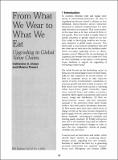| dc.contributor.author | Dolan, Catherine S. | en |
| dc.contributor.author | Tewari, Meenu | en |
| dc.date.accessioned | 2016-02-01T13:49:18Z | |
| dc.date.available | 2016-02-01T13:49:18Z | |
| dc.date.issued | 01/07/2001 | en |
| dc.identifier.citation | Dolan, C., S. and Tewari, M. (2001) From What We Wear to What We Eat . IDS Bulletin 32(3): 94-104 | en |
| dc.identifier.issn | 1759-5436 | en |
| dc.identifier.uri | https://opendocs.ids.ac.uk/opendocs/handle/20.500.12413/8748 | |
| dc.description.abstract | Summaries In recent academic debates, upgrading has emerged as a key way for developing countries to meet the competitive challenges of globalisation and trade liberalisation. This article draws on global commodity chains literature to comparatively explore the conditions within which upgrading occurs in two sectors: export horticulture in Kenya and textile/apparel in Tamil Nadu, India. In both sectors upgrading into new products, functions or markets has generated increased employment and sustained incomes. However, firms in horticulture and textile/apparel are governed by a small number of global buyers with demanding requirements. Firms without the linkages to these buyers or the capabilities to meet their requirements can be locked out of international markets. The article concludes that insertion into global value chains creates varying outcomes for developing country firms, both providing and circumscribing opportunities for broad?based development. | en |
| dc.format.extent | 11 | en |
| dc.publisher | Institute of Development Studies | en |
| dc.relation.ispartofseries | IDS Bulletin Vol. 32 Nos. 3 | en |
| dc.rights.uri | http://www.ids.ac.uk/files/dmfile/IDSOpenDocsStandardTermsOfUse.pdf | en |
| dc.title | From What We Wear to What We Eat | en |
| dc.type | Article | en |
| dc.rights.holder | © 2001 Institue of Development Studies | en |
| dc.identifier.doi | 10.1111/j.1759-5436.2001.mp32003010.x | en |

